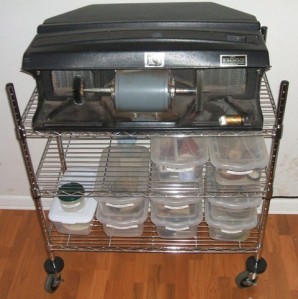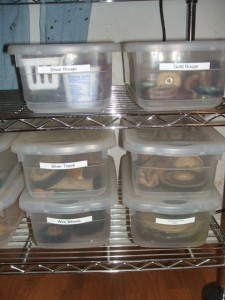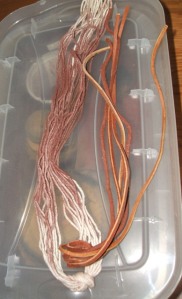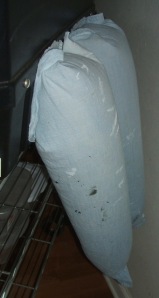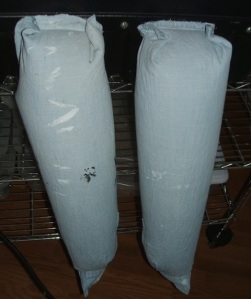With the new year comes an editorial schedule
I’ll be happily sharing many of the operations and processes which make my studio work for me.
topics in this post
metro shelves with casters
shoe box storage/buffing station organization
label maker
dust control shop modification to buffing machine
buff recycling
buff maintenance – rake and wheel dresser (added 20120211)
Safety
wire shelves with casters
I like wheels so most of my storage and some workstations, like the buffer, are on casters. I can move things around in a small space. Watch for sales on the wire shelving/Metro Shelves. The 18 inch deep works best for visibility, shoe boxes and most of the totes or boxes I use. Always buy the largest set of shelving and use half, like the buffing station, and the other half for another desk-high shelf (I know they come with a limited number of shelves. After a few years of buying when they go on sale you end up with a supply of parts to configure the way you want. Start with one and go)
shoe box storage/buffing station organization
There are many small parts and tools in the studio and after a while you may get as tired as I did of digging through a large box. My decision to use clear shoe boxes started with the purchase of a bulk pack of 6 for $5. After stowing a few things I went back for more. You can find these at any home/DIY/big box. When they drop below a buck apiece w/lids (don’t forget to get lids they’re included) I buy more. Keep all compounds and buffs separated in closed/lidded boxes. Contamination of buffs with dirt or other compounds ruins them and they can waste hours of prep and final polish on your work.
label maker
A friend bought me a label maker years ago – one of the most practical additions to the studio or workshop. If you know what is in a box you know two things: what is in there; and what doesn’t go in there. They are about $20-30. At least use peel back labels and a Sharpie if you don’t want to spend $30. Organize.
dust control shop modification to buffing machine
In earlier posts I talked about using the buffer and using a buffing machine creates dust. Period. See this post for ideas on an area dust collector for $20 for your studio. Crafters know the glue gun is an indispensable tool in the studio arsenal. The problem was my buffer was still sending dust out of the filter exhaust ports into the studio. When you figure hours of buffing that is a lot of dust and extra time cleaning. Part of the mental gymnastics one goes through to solve this type of problem is just looking around at what you have and saying “What if I do this with that?” I saw the rag bag and a glue gun in a newly opened un-sorted box. I cut sleeves from an old chambray shirt and plugged in the glue gun. I was done in less than an hour and this made a great difference in airborne cotton fibers. Glue the cuffs shut, glued top corners on the sleeves so they would drop vertically then glued each to the buffer case. This was done so I could use the buffer in nearly the same footprint as the shelving, near a wall for instance, and the sleeve bags wouldn’t stick out like an airport windsock. Images shown with buffer on.
buff recycling
You may notice in the tripoli box some ring buffs look like they were used with rouge. I bought new ring buffs for rouge as the old ones were getting thin and the old ones went in the tripoli box. You can recycle buffs towards larger grits (tripoli is more aggressive than rouge) but not the other way. Tripoli on a rouge stage buff ruins the final polish. All of my steel buffs used to be some other application for non-ferrous surface finish. For final on steel I usually use Fabulustre.
Buff maintenance
Here are two tools I use with the buffing station. The star wheel dresser is used to remove grooves or a radius from a hard felt wheel. The stars or spurs spin freely on an axle and bite enough to wear down the high spots until the face is true or one plane – it is moved side to side slowly and you will develop a touch after using it. The second tool, the rake, is used with cotton or muslin buffs after they accumulate too much compound. You will notice the polishing action decreasing. A couple of smooth passes through the face of the buff knocks the matted compound/fibers loose and the buff works efficiently again. I made the rake using a piece of oak flooring scrap. A solid thick piece of wood about 6 x 2 x 1″ with good grain and no cracks will work. Drill small pilot holes for nails (these are 16d) on the end, drive the nails in, use a cutting disc to cut off nail heads, use small rough carbide wheel or hand file to re-shape nails to a point and you are done. Another quick way to flat dress a hard felt wheel is with the edge of an old flat file or piece of steel strap.
Safety
While buffing: always wear eye protection/ face shield; Never wear gloves – use clamps and holding devices cautiously, I sometimes use finger tape from Gesswein; unless I’m working on one piece I’ll save up a large batch of pieces to polish so I can quickly switch to another piece before it gets too hot that way I don’t burn and let go; wear ear plugs; I don’t wear long sleeves; and no hair hanging – you can literally get scalped or die. (A Yale student died when her hair was caught in a spinning lathe. Many accidents are foreseeable or have happened to someone else. Tragic events happen quickly. Don’t take chances). Maintain buffs with rakes, dressers and wheels, use light pressure and re-charge, don’t press harder.
Take a break.
Work Safely.
Marshall
